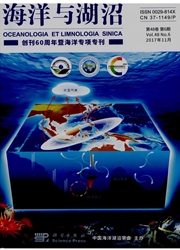

 中文摘要:
中文摘要:
^60Co-γ射线辐照处理野生型条斑紫菜的壳孢子萌发体以获得色素变异细胞,随后用酶解法获得单离的变异细胞进行个体再生培养,从中分离出不同的条斑紫菜色素突变体。结果表明,叶状体经剂量分别为100、300、500、700和900Gy的1,射线辐照后再培养1周,均出现了多种色素变异细胞,随后,它们逐渐分裂成为变异细胞块。在0—500Gy辐照剂量范围内,色素变异细胞块的百分率随着辐照剂量的增加而增加,但增至700Gy时,变异细胞块的百分率反而下降,说明500Gv是最合适的剂量。从单离变异细胞的再生叶状体中分离出桔红、紫红、桔黄和墨绿等颜色的单色变异体,并获得了它们的丝状体纯系。各变异品系的F1叶状体均为单色,其颜色与各自的母本叶状体相同,表明它们是稳定突变体。各色素突变品系的叶状体活体吸收光谱不仅与野生型品系有明显的差异,而且各突变品系之间也、存在较大的差异。
 英文摘要:
英文摘要:
To obtain pigmentation mutants of Porphyra yezoensis Ueda, single somatic cells were isolated enzymatically from the ^60Co-γ-ray-irradiated conchosporlings of the wild-type strain and were cultured to regenerate into whole blades. After irradiated at 100, 300, 500, 700, and 900Gy and cultured for 1 week, the color-mutated cells in different col- ors appeared in the irradiated blades. These cells formed cell-clusters in the next three weeks of culture. As irradiation dosage increased from 0 to 500Gy, the frequency of the color-mutated cell-clusters increased; however, beyond 700Gy, the frequency decreased. Therefore, 500Gy is the optimal dosage for inducing mutations. The frequency of the color-mutated cell-clusters varied in different parts of blade, increased from the base to the tip of the blade. Many mutant blades in dif- ferent colors appeared in the regenerated blades from the single cells. Five pigmentation mutants (red orange, purplish red, yellow orange, olive, and green color) were isolated and their free-living conchocelis were established by sexual reproduction. The F1 gametophytic blades of each mutant strains showed only one color that the same to its mother blade, indicating they have become relatively stable pigmentation mutants. Each mutant strain featured own characteristics in absorption spectra of in vivo blades, different from each other and from wild type's.
 同期刊论文项目
同期刊论文项目
 同项目期刊论文
同项目期刊论文
 Genetic analysis of the position of meiosis in Porphyra haitanensis Chang et Zheng (Bangiales, Rhodo
Genetic analysis of the position of meiosis in Porphyra haitanensis Chang et Zheng (Bangiales, Rhodo 期刊信息
期刊信息
